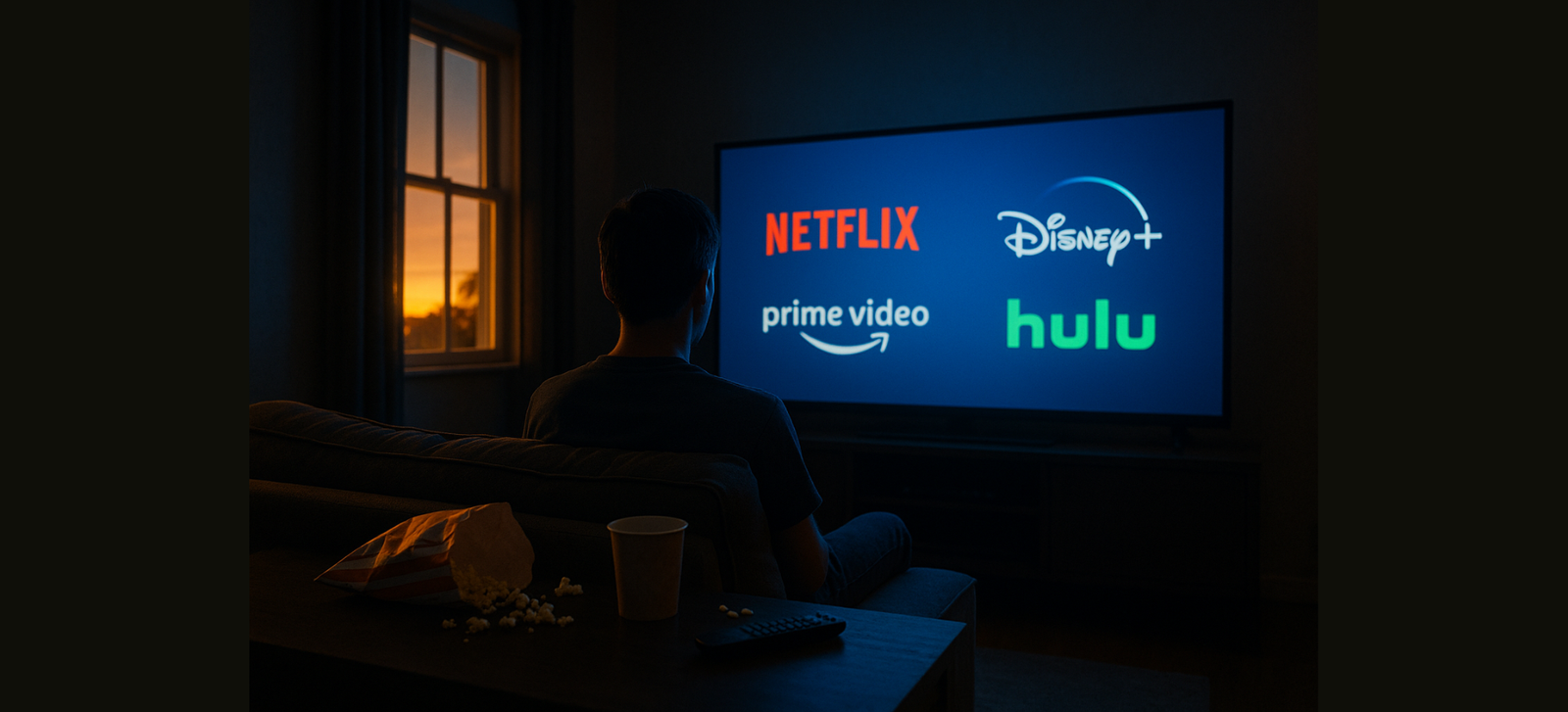Movies hijack our brains with engineered addiction. From dopamine loops to escape fantasies, here’s why we can’t stop watching and what our viewing habits reveal about human nature.
I watched four Marvel movies last weekend.
Not because I planned to. Not because I was particularly interested in the plot. But because Netflix’s algorithm knows something about my brain that I’m only beginning to understand.
Each movie ended with just enough unresolved tension to make the next one feel necessary. Each credit sequence teased future storylines. Each viewing session left me simultaneously satisfied and hungry for more.
I wasn’t just watching entertainment. I was experiencing engineered addiction.
The Dopamine Factory
Movies aren’t just stories—they’re neurochemical experiences designed to hijack our reward systems.
Every plot twist triggers a dopamine release. Every emotional climax floods our brains with neurochemicals. Every cliffhanger creates a craving loop that keeps us coming back.
Neuroscientist Dr. Anna Lembke’s research on dopamine and addiction shows that our brains respond to predictable entertainment rewards the same way they respond to addictive substances. <cite>¹</cite> The anticipation of pleasure becomes more powerful than the pleasure itself.
This explains why we can binge-watch mediocre shows for hours but struggle to finish important books. Movies provide instant, reliable dopamine hits. Books require sustained attention and delayed gratification.
The Escape Hatch
But movie addiction isn’t just about neurochemistry. It’s about psychological escape.
Films offer temporary relief from the complexity of real life. In movies, problems have solutions. Heroes win. Justice prevails. Conflicts resolve in 90-120 minutes.
Real life, meanwhile, is messy, uncertain, and rarely provides clear narrative arcs.
Psychologist Dr. Sherry Turkle’s research on digital escapism reveals that we increasingly use media consumption to avoid the discomfort of being alone with our thoughts. <cite>²</cite> Movies become emotional anesthesia, numbing us to present-moment anxiety.
The Identification Drug
We don’t just watch movies—we project ourselves into them.
When we see characters overcome obstacles, our brains experience vicarious achievement. When heroes triumph, we feel triumphant. When protagonists find love, we experience emotional satisfaction without the vulnerability of real relationships.
This psychological phenomenon, called “transportation” by media researchers, allows us to experience emotional rewards without real-world risks. <cite>³</cite> We get the neurochemical benefits of adventure, romance, and success without leaving our couches.
The Community Substitute
Movie franchises create artificial tribes.
Marvel fans. Star Wars enthusiasts. Horror aficionados. These aren’t just entertainment preferences—they’re identity markers that provide social belonging in an increasingly disconnected world.
Anthropologist Dr. Sarah Banet-Weiser’s research on “brand cultures” shows how entertainment properties function as modern tribal affiliations, giving people shared languages, values, and rituals. <cite>⁴</cite> Discussing the latest Marvel movie serves the same social function that discussing village gossip did for our ancestors.
The Predictable Surprise
Movie addiction thrives on the paradox of predictable surprise.
We know the hero will probably win, but we don’t know exactly how. We understand the romantic leads will likely end up together, but the path remains uncertain. This creates what behavioral economist Dr. B.F. Skinner called “variable ratio reinforcement”—the most addictive type of reward schedule. <cite>⁵</cite>
Casino slot machines use the same principle. So do social media notifications. And so do movie franchises that promise familiar satisfaction with slight variations.
The Emotional Regulation System
Different moods drive us to different genres, revealing how we use movies as emotional drugs.
Feeling powerless? Action movies provide vicarious control. Feeling lonely? Romantic comedies offer connection fantasies. Feeling anxious? Familiar sitcoms provide comfort and predictability. Feeling bored? Thrillers deliver artificial excitement.
Clinical psychologist Dr. Mary Alvord’s research on emotional regulation shows that people increasingly use media consumption as a primary coping mechanism rather than developing internal emotional management skills. <cite>⁶</cite> Movies become external mood regulators rather than entertainment choices.
The Attention Economy Trap
Streaming platforms have weaponized our viewing habits.
Autoplay features eliminate friction between episodes. Recommendation algorithms create content tunnels designed to maximize viewing time. “Limited series” create artificial scarcity that drives immediate consumption.
Tech critic Shoshana Zuboff’s analysis of “surveillance capitalism” reveals how entertainment platforms extract value not just from our viewing choices but from the behavioral data those choices generate. <cite>⁷</cite> We’re not just consumers—we’re products being optimized for engagement.
The Reality Avoidance System
Perhaps most concerning is how movie addiction facilitates reality avoidance.
Instead of processing difficult emotions, we distract ourselves with fictional conflicts. Instead of developing real relationships, we form parasocial bonds with characters. Instead of pursuing meaningful goals, we experience secondhand achievement through protagonists.
Psychiatrist Dr. Carl Jung warned about the psychological dangers of living vicariously: “The privilege of a lifetime is to become who you truly are.” <cite>⁸</cite> When we spend more time with fictional characters than with ourselves, we risk becoming fictional versions of ourselves.
The Comfort Zone Expansion
Not all movie consumption is problematic. Films can expand empathy, expose us to different perspectives, and provide shared cultural experiences.
The key difference lies in intention versus compulsion.
Choosing to watch a specific film for artistic appreciation or social connection is different from mindlessly consuming content to avoid discomfort. The former enhances life; the latter replaces it.
The Awareness Antidote
Breaking movie addiction doesn’t require eliminating films entirely. It requires conscious consumption.
Before starting a movie, ask yourself:
- Am I choosing this or avoiding something else?
- What emotional need am I trying to meet?
- How will I feel after watching this?
- What real-world activity am I postponing?
Media literacy researcher Dr. James Potter emphasizes that conscious media consumption requires understanding both the content’s effects on us and our motivations for consuming it. <cite>⁹</cite>
The Replacement Therapy
The most effective way to reduce movie addiction is replacing it with activities that provide similar psychological benefits more healthily.
Need adventure? Try new experiences in real life. Want community? Join actual groups with shared interests. Seeking achievement? Pursue meaningful personal goals. Craving narrative? Read books that require active imagination.
The Mirror Effect
Our movie addiction reveals profound truths about modern life:
We’re often bored, so we seek artificial excitement. We’re frequently lonely, so we pursue parasocial relationships. We feel powerless, so we identify with fictional heroes. We avoid difficult emotions, so we prefer manufactured feelings.
These aren’t character flaws—they’re symptoms of a culture that prioritizes consumption over creation, stimulation over reflection, and entertainment over engagement.
The Real Plot Twist
The most addictive story isn’t on any screen—it’s the one you’re living.
Your real life contains more plot twists, character development, and emotional depth than any screenplay. The difference is that your story requires you to be the protagonist, not just the audience.
Movie addiction often stems from forgetting that your life is the most interesting story you’ll ever encounter. It just requires more participation than passive consumption.
The next time you reach for the remote, pause and ask: “What story am I avoiding by watching someone else’s?”
Your answer might be the beginning of breaking free from the screen and stepping back into your own fascinating, unpredictable, beautifully messy narrative.
The credits are rolling on this post, but your real story is just beginning.
Ready to examine what else might be hijacking your attention?
Subscribe below for weekly explorations of the hidden psychology behind our daily habits and choices.
Real insights for people ready to live more consciously.
Your next breakthrough starts with awareness.
Citations:
- Lembke, Anna. Dopamine Nation: Finding Balance in the Age of Indulgence. Dutton, 2021.
- Turkle, Sherry. Alone Together: Why We Expect More from Technology and Less from Each Other. Basic Books, 2011.
- Green, Melanie C., and Timothy C. Brock. “The role of transportation in the persuasiveness of public narratives.” Journal of Personality and Social Psychology, vol. 79, no. 5, 2000, pp. 701-721.
- Banet-Weiser, Sarah. Authentic™: The Politics of Ambivalence in a Brand Culture. NYU Press, 2012.
- Skinner, B.F. Science and Human Behavior. Macmillan, 1953.
- Alvord, Mary K., et al. “Building resilience in children and teens: Giving kids roots and wings.” American Psychological Association, 2011.
- Zuboff, Shoshana. The Age of Surveillance Capitalism: The Fight for a Human Future at the New Frontier of Power. PublicAffairs, 2019.
- Jung, Carl G. Memories, Dreams, Reflections. Vintage Books, 1961.
- Potter, W. James. Media Literacy. SAGE Publications, 2018.


Leave a Reply